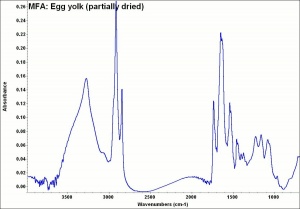Egg yolk
Description
The interior yellow, spherical portion of a bird Egg. The yolk from a hen egg is composed of about 50% Water, 15% Protein, 22% lipids, 9% Lecithin and 3% other materials. The distribution of major amino acids is: Glutamic acid (15.0%), aspartic acid (11.5%), Leucine (9.2%), Lysine (5.7%), valine (6.4%), arginine (5.5%), Alanine (5.6%), isoleucine (5.1%) and serine (9.1%) with no measurable amounts of Hydroxyproline (Mills and White 1994). Egg yolk is a natural emulsion that dries into a strong, water-insoluble film, first by the evaporation of water, then by the hardening of the lipids (Gettens and Stout, 1966). When used traditionally as a paint medium, the pure egg yolk is carefully separately from the egg white, then rolled back and forth in the hands to dry the surface of the sac. The sac is pierced to release its contents which are then ground with pigments. Vinegar was sometimes added as a preservative.
Synonyms and Related Terms
deutoplasm
Physical and Chemical Properties
- Soluble in water after drying.
- Insoluble in water after heating.
Resources and Citations
- R. J. Gettens and G.L. Stout, Painting Materials, A Short Encyclopaedia, Dover Publications, New York, 1966.
- Hermann Kuhn, Conservation and Restoration of Works of Art and Antiquities, Butterworths, London, 1986
- John S. Mills, Raymond White, The Organic Chemistry of Museum Objects, Butterworth Heineman, London, 2nd ed., 1994
- Encyclopedia Britannica, http://www.britannica.com Comment: "Yolk." [Accessed 14 Apr. 2004].
